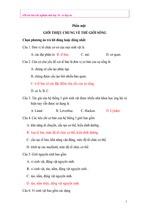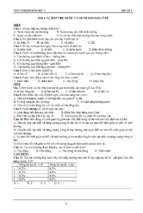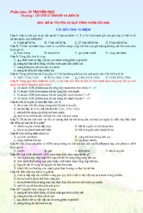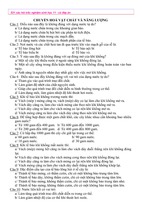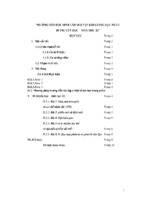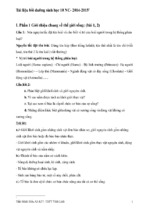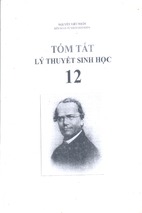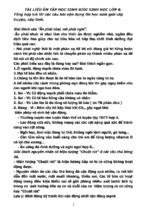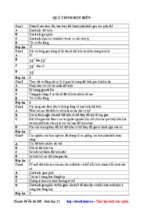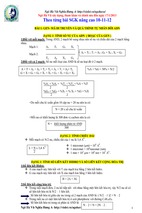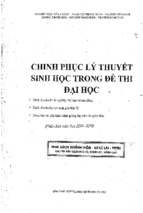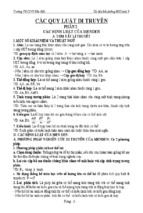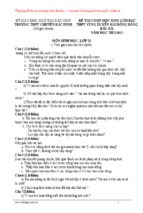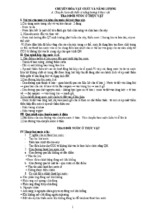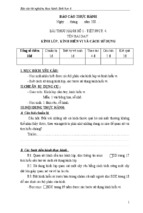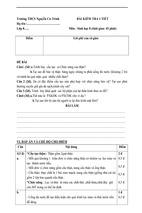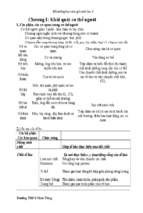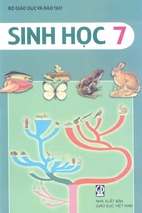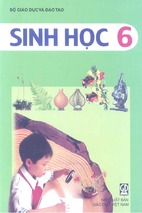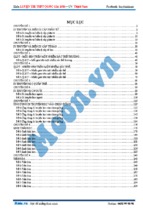ỦY BAN NHÂN DÂN TỈNH ĐỒNG THÁP
TRƢỜNG CAO ĐẲNG CỘNG ĐỒNG ĐỒNG THÁP
GIÁO TRÌNH
(Ban hành kèm theo Quyết định số
/QĐ-CĐCĐ ngày
tháng
năm 2017
của Hiệu trưởng trường Cao đẳng Cộng đồng Đồng Tháp)
MÔN HỌC/ MÔ ĐUN: ANH VĂN CHUYÊN NGÀNH CÔNG
NGHỆ THỰC PHẨM
NGÀNH, NGHỀ: CÔNG NGHỆ THỰC PHẨM
TRÌNH ĐỘ: CAO ĐẲNG
Đồng Tháp, năm 2017
TUYÊN BỐ BẢN QUYỀN
Tài liệu này thuộc loại sách giáo trình nên các nguồn thông tin có thể được phép
dùng nguyên bản hoặc trích dùng cho các mục đích về đào tạo và tham khảo.
Mọi mục đích khác mang tính lệch lạc hoặc sử dụng với mục đích kinh doanh
thiếu lành mạnh sẽ bị nghiêm cấm
LỜI GIỚI THIỆU
Giáo trình Anh văn chuyên ngành nhằm cung cấp ngữ liệu của ngành Thực
phẩm và trong những ngôn cảnh của chuyên ngành này giúp người đọc hình thành các
kỹ năng đọc hiểu với các cấu trúc cơ bản nhất hay gặp trong các tài liệu khoa học, nhất
là thuộc lĩnh vực Công nghệ thực phẩm. Các câu hỏi theo nội dung bài học nhằm giúp
người học phát triển kỹ năng nghe nói. Các câu dịch bước đầu chuẩn bị cho người học
hình thành kỹ năng viết theo văn phong khoa học của ngành. Giáo trình gồm 13 bài:
Unit 1 introduction
Unit 2 essential nutrients
Unit 3 food groups
Unit 4 fermentation
Unit 5 additives
Unit 6 food preservation
Unit 7 organic food
Unit 8 beer
Unit 9 soft drinks
Unit 10 dairy products
Unit 11 meat and fish products
Unit 12 vegetables processing and preservation
Unit 13 introduction to food safety
Unit 14 food packaging
Unit 15 job application
Cùng với mỗi bài khóa có bài luyện và ôn ngữ pháp cơ bản, như vậy sinh viên
có thể đọc sách kỹ thuật tốt hơn nhiều. Việc biên soạn cuốn sách này cũng không tránh
khỏi khiếm khuyết, xin nhận được sự góp ý xây dựng của độc giả và người học.
Đồng Tháp, ngày … tháng … năm 2017
Chủ biên
i
MỤC LỤC
Trang
UNIT 1 INTRODUCTION ................................................................................. 9
UNIT 2 ESSENTIAL NUTRIENTS .................................................................. 9
UNIT 3 FOOD GROUPS.................................................................................. 12
UNIT 4 FERMENTATION .............................................................................. 13
UNIT 5 ADDITIVES......................................................................................... 15
UNIT 6 FOOD PRESERVATION .................................................................. 16
UNIT 7 ORGANIC FOOD ............................................................................... 18
UNIT 8 BEER .................................................................................................... 19
UNIT 9 SOFT DRINKS .................................................................................... 20
UNIT 10 DAIRY PRODUCTS ......................................................................... 22
UNIT 11 MEAT AND FISH PRODUCTS ...................................................... 23
UNIT 12 VEGETABLES PROCESSING AND PRESERVATION ............ 25
UNIT 13 INTRODUCTION TO FOOD SAFETY ........................................ 27
UNIT 14 FOOD PACKAGING ....................................................................... 28
UNIT 15 JOB APPLICATION ........................................................................ 28
TÀI LIỆU THAM KHẢO ................................................................................ 31
ii
CHƢƠNG TRÌNH MÔN HỌC
Tên môn học: Anh văn chuyên ngành Công nghệ thực phẩm.
Mã môn học: CCN209
Thời gian thực hiện môn học: 30 giờ; (Lý thuyết: 28 giờ; thực hành: 0giờ; Kiểm tra 2
giờ)
I. Vị trí, tính chất của môn học:
- Vị trí: Môn học Anh văn chuyên ngành Công nghệ thực phẩm thuộc nhóm các môn
học cơ sở tự chọn được bố trí giảng dạy sau khi đã học xong các môn học đại cương
như là pháp luật, chính trị, tin học, giáo dục thể chất, giáo dục quốc phòng.
- Tính chất: Môn học Anh văn chuyên ngành Công nghệ thực phẩm cung cấp cho
sinh viên cao đẳng công nghệ thực phẩm những kiến thức và kỹ năng tiếng Anh cơ
bản liên quan đến chuyên môn công nghệ thực phẩm; làm nền tảng vững chắc gíup
cho người học có thể hiểu dễ dàng hơn những kiến thức tiếng Anh chuyên nghành ở
cấp độ cao hơn và có thể tham khảo tài liệu chuyên nghành công nghệ thực phẩm bằng
tiếng Anh.
II. Mục tiêu môn học:
- Kiến thức:
+ Nâng cao vốn từ vựng thường được sử dụng liên quan đến công nghệ thực phẩm.
+ Hiểu được một số thuật ngữ công nghệ thực phẩm bằng tiếng Anh một cách cơ bản.
+ Nắm được kiến thức liên quan đến các nhóm thực phẩm; thực phẩm hữu cơ; sự lên
men; các sản phẩm thịt, cá, sữa, bia, nước giải khát, các sản phẩm đóng hộp...; bảo
quản và chế biến rau củ; các cách bảo quản thực phẩm; an toàn vệ sinh thực phẩm; bao
bì đóng gói và phụ gia.
- Kỹ năng:
+ Môn học giúp sinh viên nâng cao kỹ năng đọc hiểu; viết đoạn văn, tóm tắt, thuyết
trình, làm việc nhóm.
+ Viết emails, CV và đơn xin việc bằng tiếng Anh.
- Về năng lực tự chủ và trách nhiệm:
+ Có ý thức tích cực, chủ động trong quá trình học tập.
+ Trung thực trong kiểm tra và thi.
III. Nội dung môn học:
1. Nội dung tổng quát và phân bổ thời gian:
Số
TT
Thời gian (giờ)
Tổng
Lý
Thực Kiểm
số thuyết hành tra
Tên chƣơng, mục
UNIT 1 INTRODUCTION
1.1. Lead-in: Video Watching - Describe Food
Technology Course in Holland.
1 1.2. Vocabulary: Fundamental activities of all living
organisms; processes in food technology.
1.3. Reading: Food, Nutrition and Food Technology
1.4. Skills: Explain the reasons for choosing food
technology course
UNIT 2: ESSENTIAL NUTRIENTS
2 2.1. Lead-in: Brainstorming activity – Essential
1
2
2
0
2
2
0
3
4
5
6
7
8
9
10
nutrients
2.2.Vocabulary: Essential nutrients in human diet
2.3. Reading: Essential nutrients
2.4. Skills: participating in a discussion
UNIT 3: FOOD GROUPS
3.1. Lead-in: Picture Matching
3.2. Vocabulary: Food groups
3.3. Reading: Food groups
3.4. Skill: Mind Map - Summary
UNIT 4: FERMENTATION
4.1. Lead-in: Doing an experiment – Observing yeast
activity
4.2. Vocabulary: fermentation; fermentation products;
fermentation process.
4.3. Reading: the history of fermentation
4.4. Skill: exchanging information – jigsaw reading
UNIT 5: ADDITIVE
5.1. Lead-in: video-watching
5.2.Vocabulary: additive
5.3. Reading: The introduction to Additive
5.4. Skill: Discussion – The advantages and
disadvantages of additive
UNIT 6: FOOD PRESERVATION
6.1. Lead-in: Picture - matching
6.2.Vocabulary: preservation methods of food
6.3. Reading: The introduction to food preservation
6.4. Skill: Presentation – presenting the preservative
method of a certain food
UNIT 7: ORGANIC FOOD
7.1. Lead-in: video-watching
7.2.Vocabulary: Organic food
7.3. Reading: Organic food
7.4. Skill: Mind – map: Summary
UNIT 8: BEER
8.1. Lead-in: video-watching
8.2.Vocabulary: beer, material, manufacturing process
8.3. Reading: Beer
8.4. Skill: starting a presentation – the manufacturing
process of beer
UNIT 9 SOFT DRINKS
9.1.Lead-in: Gap-fill: The Invention of Coca-Cola
9.2.Vocabulary: soft drinks
9.3. Reading: Coca - Cola
9.4. Skill: Presentation – the manufacturing process of
Coca-Cola
UNIT 10 DAIRY PRODUCTS
10.1. Lead-in: guessing game
2
2
2
0
2
2
0
1
1
0
2
2
0
2
2
0
2
1
0
1
1
0
1
1
0
1
10.2. Vocabulary: dairy products
10.3. Reading: The manufacturing process of milk and
dairy products
10.4. Skill: Presentation – the manufacturing process
of dairy products to make cheese and cheese products
UNIT 11 MEAT AND FISH PRODUCTS
11.1. Lead-in: Discussion – your favourite meat and
fish products
11 11.2. Vocabulary: Meat and fish products
2
2
0
11.3. Reading: Common meat and fish products
11.4. Skill: presentation – manufacturing process of
fish sauce
UNIT 12 VEGETABLES PROCESSING AND
PRESERVATION
12.1. Lead-in: Discussion
12.2. Vocabulary: Vegetables; processing and
12
2
2
0
preservation
12.3. Reading: Vegetables processing and preservation
12.4. Skill: presentation – manufacturing process of
vegetables
UNIT 13 INTRODUCTION TO FOOD SAFETY
13.1. Lead-in: Video – watching - Discussion
13.2. Vocabulary: food safety; quality; hygiene;
13
2
2
0
HACCP
13.3. Reading: Introduction to food safety
13.4. Skill: presentation – food safety
UNIT 14: FOOD PACKAGING
14.1. Lead-in: video-watching
14 14.2.Vocabulary: packaging
4
4
0
14.3. Reading: Smartness in Packaging
14.4. Skill: designing and present a product packaging
UNIT 15: JOB APPLICATION
15.1. Lead-in: Video-watching – Job interview
15.2. Vocabulary: CV, job application form
15
3
2
0
15.3. Reading: Emails, CV, job application form
15.4. Skill: Job interview; write a CV & job
application form
Cộng
30
28
0
2. Nội dung chi tiết:
UNIT 1 INTRODUCTION
Thời gian: 2 giờ
1. Mục tiêu : By the end of the unit, students will be able to:
- Give definition of food in broad meaning and in terms of energy needs
- Give the definition of some terms of food and nutrition
- Give the definition of food technology
2. Nội dung:
2.1. Lead-in: Video Watching - Describe Food Technology Course in Holland.
3
1
2
2.2. Vocabulary: Fundamental activities of all living organisms; processes in food
technology.
2.3. Reading: Food, Nutrition and Food Technology
Multiple choice exercise
Matching
True/False statements
Gap-fill
2.4. Skills: Explain the reasons for choosing food technology course
UNIT 2 ESSENTIAL NUTRIENTS
Thời gian: 2 giờ
1.Mục tiêu: By the end of the unit, students will be able to:
- Distinguish essential nutrients
- Master the importance of each kind of nutrient
2. Nội dung:
2.1. Lead-in: Brainstorming activity – Essential nutrients
2.2. Vocabulary: Essential nutrients in human diet
2.3. Reading: Essential nutrients
True/False statements
Gap-fill
Identification
2.4. Skills: participating in a discussion
UNIT 3 FOOD GROUPS
Thời gian: 2 giờ
1.Mục tiêu: By the end of the unit, students will be able to:
- Distinguish groups of foods
- Master the importance of each kind of food
2. Nội dung:
2.1. Lead-in: Picture Matching
2.2. Vocabulary: Food groups
2.3. Reading: Food groups
True/False statements
Gap-fill
Identification
2.4. Skill: Mind Map - Summary
UNIT 4 FERMENTATION
Thời gian: 2 giờ
1. Mục tiêu: By the end of the unit, students will be able to:
- Give definition of fermentation; the history of fermentation
- Explore some fermented products
2. Nội dung:
2.1. Lead-in: Doing an experiment – Observing yeast activity
2.2. Vocabulary: fermentation; fermentation products; fermentation process.
2.3. Reading: the history of fermentation
True/False statements
Identification
2.4. Skill: exchanging information – jigsaw reading
UNIT 5 ADDITIVES
Thời gian: 1 giờ
1. Mục tiêu: By the end of the unit, students will be able to:
- Give the definition of a food additive; classification of food additives
4
- Discuss about the effects of additive; the advantages and disadvantages of
additive
2. Nội dung:
2.1. Lead-in: video-watching
2.2.Vocabulary: additive
2.3. Reading: The introduction to Additive
Questions - answers
2.4. Skill: Discussion – The advantages and disadvantages of additive
UNIT 6 FOOD PRESERVATION
Thời gian: 2 giờ
1. Mục tiêu: By the end of the unit, students will be able to:
- Give the definition of food preservation;
- Explore some common methods of preserving food.
2. Nội dung:
2.1. Lead-in: Picture - matching
2.2.Vocabulary: preservation methods of food
2.3. Reading: The introduction to food preservation
True/False statements
Gap-fill
Questions - answers
2.4. Skill: Presentation – presenting the preservative method of a certain food
UNIT 7 ORGANIC FOOD
Thời gian: 2 giờ
1. Mục tiêu: By the end of the lesson, students will be able to:
- Know what organic food is.
- Distinguish types of organic food and its characteristics.
- Know how to identify organic food
2. Nội dung:
2.1. Lead-in: video-watching
2.2. Vocabulary: Organic food
2.3. Reading: Organic food
True/False statements
Gap-fill
Questions - answers
2.4. Skill: Mind – map: Summary
UNIT 8 BEER
Thời gian: 2 giờ
1. Mục tiêu: By the end of the lesson, students will be able to:
- Present the manufacturing process of beer
2.Nội dung:
2.1. Lead-in: video-watching
2.2.Vocabulary: beer, material, manufacturing process
2.3. Reading: Beer
Questions – Answers
2.4. Skill: starting a presentation – the manufacturing process of beer
2.5. Kiểm tra
UNIT 9 SOFT DRINKS
Thời gian: 1 giờ
1. Mục tiêu: By the end of the lesson, students will be able to:
- Present the manufacturing process of soft drinks
2.Nội dung:
5
2.1.Lead-in: Gap-fill: The Invention of Coca-Cola
2.2.Vocabulary: soft drinks
2.3. Reading: Coca – Cola
Questions – Answers
2.4. Skill: Presentation – the manufacturing process of Coca-Cola
UNIT 10 DAIRY PRODUCTS
Thời gian: 1 giờ
1. Mục tiêu: By the end of the lesson, students will be able to:
- Present the manufacturing process of dairy products
2.Nội dung:
2.1. Lead-in: guessing game
2.2. Vocabulary: dairy products
2.3. Reading: The manufacturing process of milk and dairy products
Questions – Answers
2.4. Skill: Presentation – the manufacturing process of dairy products to make
cheese and cheese products
UNIT 11 MEAT AND FISH PRODUCTS
Thời gian: 2 giờ
1. Mục tiêu: By the end of the lesson, students will be able to:
- Present the manufacturing process of meat and fish products
2.Nội dung:
2.1. Lead-in: Discussion – your favourite meat and fish products
2.2. Vocabulary: Meat and fish products
2.3. Reading: Common meat and fish products
Questions – Answers
2.4. Skill: presentation – manufacturing process of fish sauce
UNIT 12 VEGETABLES PROCESSING AND PRESERVATION
Thời gian: 2 giờ
1. Mục tiêu: By the end of the lesson, students will be able to:
- Present vegetables process and preservation
2.Nội dung:
2.1. Lead-in: Discussion
2.2. Vocabulary: Vegetables; processing and preservation
2.3. Reading: Vegetables processing and preservation
Questions – Answers
2.4. Skill: presentation – manufacturing process of vegetables
UNIT 13 INTRODUCTION TO FOOD SAFETY
Thời gian: 2 giờ
1. Mục tiêu: By the end of the lesson, students will be able to:
- Discuss about food safety and quality and hygiene; what HACCP is; the history
of HACCP; seven principles of HACCP
2.Nội dung:
2.1. Lead-in: Video – watching - Discussion
2.2. Vocabulary: food safety; quality; hygiene; HACCP
2.3. Reading: Introduction to food safety
Questions – Answers
2.4. Skill: presentation – food safety
UNIT 14 FOOD PACKAGING
Thời gian: 4 giờ
1. Mục tiêu: By the end of the lesson, students will be able to:
- Know what food packaging is; food packaging materials; the way of packaging
6
- Design and present a product packaging
2.Nội dung:
2.1. Lead-in: video-watching
2.2.Vocabulary: packaging
2.3. Reading: Smartness in Packaging
Questions – Answers
2.4. Skill: designing and present a product packaging
UNIT 15 JOB APPLICATION
Thời gian: 3 giờ
1. Mục tiêu: By the end of the lesson, students will be able to:
- Write an email; CV and job application
2.Nội dung:
2.1. Lead-in: Video-watching – Job interview
2.2. Vocabulary: CV, job application form
True/False statements
Gap-fill
Questions - answers
Identification
2.3. Reading: Emails, CV, job application form
2.4. Skill: Job interview; write a CV & job application form
2.5. Kiểm tra
.KIỂM TRA: 2 giờ
IV. Điều kiện thực hiện môn học:
- Phòng học lý thuyết
- Máy tính, máy chiếu projector
- Đề cương, giáo án, bài giảng môn hoc, giáo trình, tài liệu tham khảo
- Giáo trình, tài liệu phát tay và các tài liệu liên quan khác
- Câu hỏi, bài tập thực hành
V. Nội dung và phƣơng pháp, đánh giá:
1. Nội dung:
- Kiến thức:
+ từ vựng cấu trúc câu liên quan đến công nghệ thực phẩm.
+ đọc các bài báo ngắn liên quan đến lĩnh vực công nghệ thực phẩm.
- Kỹ năng:
+ Sử dụng được các từ vựng, cấu trúc, các điểm ngữ pháp để nâng cao khả năng đọc
hiểu, nghe, viết và nói tiếng Anh một cách cơ bản.
+ Vận dụng được những kiến thức đã được học vào các tình huống giao tiếp cơ bản
trong môi trường công nghệ thực phẩm.
- Về năng lực tự chủ và trách nhiệm:
+ Có ý thức tích cực, chủ động trong quá trình học tập:phát biểu ý kiến đóng góp xây
dựng bài, tham gia đầy đủ các buổi học, tự tìm tài liệu tham gia tích cực các hoạt động
thảo luận nhóm và trình bày.
+ Trung thực trong kiểm tra và thi.
2. Phƣơng pháp:
- Sử dụng tranh, video clips, sử dụng đa dạng các hoạt động trên lớp, kết hợp các
phương pháp khác nhau để tạo hiệu quả giảng dạy tốt nhất.
- Trình bày lý thuyết, bài tập thực hành, bài tập tình huống trên lớp. Cho bài tập tình
huống đóng vai thực hành các tình huống giao tiếp bằng tiếng Anh
7
3. Đánh giá môn học:
Kiểm tra đánh giá theo quy định của Bộ LĐTBXH và quy định học vụ của trường.
VI. Hƣớng dẫn thực hiện môn học:
1. Phạm vi áp dụng môn học:
Chương trình môn học được sử dụng để giảng dạy cho trình độ cao đẳng công nghệ
thực phẩm.
2. Hƣớng dẫn về phƣơng pháp giảng dạy, học tập môn học:
- Đối với giáo viên, giảng viên:
+ Công bố đề cương chi tiết môn học, giới thiệu về tài liệu chính và tài liệu tham khảo.
+ Công bố phương pháp kiểm tra đánh giá, thời gian hiện diện trên lớp.
+ Hình thức giảng dạy chính của môn học: Lý thuyết trên lớp kết hợp với bài tập cá nhân, bài tập
nhóm.
+ Giáo viên trước khi giảng dạy cần phải căn cứ vào nội dung của từng bài học chuẩn bị
đầy đủ các điều kiện thực hiện bài học để đảm bảo chất lượng giảng dạy.
- Đối với ngƣời học:
+ Cần chuẩn bị trước bài ở nhà trước khi lên lớp, bố trí thời gian khoa học đảm bảo 1
giờ học trên lớp cần 2 giờ học ở nhà.
+ Chủ động trong các hoạt động nhóm và đóng vai trong các tình huống giao tiếp bằng
tiếng Anh.
Những trọng tâm cần chú ý:
- Nắm vững các điểm ngữ pháp, từ vựng
- Tham khảo tài liệu để hoàn thành tốt các bài tập nhóm và cá nhân
- Làm bài tập đầy đủ và thường xuyên
4. Tài liệu tham khảo:
[1]. Đàn, G. T. N. T., & Chi, T. L. T. L (2009). The language of Chemistry, Food and
Biological Technology in English. Hanoi University of Science and
Technology.
[2]. Internet Resource
8
UNIT 1 INTRODUCTION
Giới thiệu: Nâng cao vốn từ vựng thường được sử dụng liên quan đến công nghệ thực
phẩm.
Mục tiêu : By the end of the unit, students will be able to:
- Give definition of food in broad meaning and in terms of energy needs
- Give the definition of some terms of food and nutrition
- Give the definition of food technology
1. Lead-in:
Chemistry is the science of substances - of their structure, their properties, and the
reactions that change them into other substances. The study of chemistry may be
divided into the following branches:
- General chemistry, which is an introduction to the entire science.
- Qualitative analysis, giving the methods of testing for the presence of chemical
substances.
- Quantitative analysis, giving the methods of accurate determination of the amounts
of different substances present in a sample of material. –
Inorganic chemistry, which is the chemistry of elements other than carbon, and their
compounds.
- Organic chemistry, which is the chemistry of the compounds of carbon.
- Physical chemistry, which studies the quantitative relations among the properties of
substances and their reactions.
- Biochemistry, which is the chemistry of the substances comprising living organisms.
- Structural chemistry, which deals with the molecular structure and its relation to the
properties of substances.
- Radiochemistry, which is the chemistry of radioactive elements and of reactions
involving the nuclei of atoms.
- Industrial chemistry, which is concerned with industrial processes.
2. Vocabulary:
Although chemistry is a very large and complex subject, which still continues to grow
as new elements are discovered or made, new compounds are synthesized, and new
principles are formulated. The chemists or chemical engineers need to have some
knowledge of all its branches, even if he may be specialized in a particular line.
Chemistry science cannot do without physics and mathematics, and is also closely
linked to some other sciences, e.g. inorganic chemistry is linked closely to geology,
mineralogy, and metallurgy, while organic chemistry is linked to biology in general.
3. Reading.
Read and translate into Vietnamese substances, reaction, chemistry, analysis, method,
determination, material, inorganic, element, compound, organic, biochemistry,
organism, molecular, radioactive, nuclei, industrial, atom, processes, synthesized,
engineer, specialized, particular, accurate, mathematics, closely, geology, mineralogy,
metallurgy, comprise, biology, concerned, knowledge, continue, sample
4. Skills
Answer the following questions
1. Give the definition of chemistry.
2. Which are the main branches of chemistry?
3. What is the difference between qualitative and quantitative analysis?
4. What is the difference between inorganic and organic chemistry?
9
5. What does physical chemistry study?
6. What does structural chemistry deal with?
7. What is radiochemistry?
8. Which branches of chemistry are you interested in?
9. Is it necessary for you to have some knowledge of all branches of chemistry?
10. Can chemistry as a science do without physics and mathematics?
Ôn tập
Translate into English
1. Hóa học là khoa học về vật chất riêng biệt.
2. Hóa học được chia thành những ngành nào?
3. Toán học là khoa học về số, còn vật lí nghiên cứu ánh sáng và nhiệt.
4. Hóa học công nghiệp quan tâm đến gì?
UNIT 2 ESSENTIAL NUTRIENTS
Giới thiệu: Nâng cao vốn từ vựng thường được sử dụng liên quan đến công nghệ thực
phẩm.
Mục tiêu: By the end of the unit, students will be able to:
- Distinguish essential nutrients
- Master the importance of each kind of nutrient
1. Lead-in:
Hydrogen, the first element in the periodic table, is a very widely distributed element.
Its most important compound is water, H2O. Hydrogen is found in most of substances,
which constitute living matter: sugar, starch, fats, and proteins. It occurs in petroleum,
petrol, and other hydrocarbon mixtures. It is also contained in all acids and alkalis.
There are more compounds of hydrogen known than of any other element. Pure
hydrogen is a colorless, odorless, tasteless gas. It is the lightest of all gases, density
being about 1/14 that of air, viz. 0.08987 gm.per liter. It does not support respiration,
but is not poisonous. Hydrogen is a good conductor of heat as compared with other
gases. Its specific heat is also higher than most other gases. Hydrogen is a combustible
gas, burning in air or oxygen with a nearly colorless flame to form water vapor.
Hydrogen also readily combines with fluorine and chlorine, less readily with bromine,
10
iodine, sulfur, phosphorus, nitrogen, and carbon. The element is made commercially
by the electrolysis of water, and is used in large quantities in the manufacture of
ammonia, in the hydrogenation of liquid fats to form solid fats, and in the production
of high temperatures. In the laboratory hydrogen may be easily prepared by the
reaction of an acid as sulfuric acid, with a metal such as zinc: H2SO4 + Zn = H2 +
ZnSO4 Hydrogen may be set free also by the action of certain metals on water. Thus
sodium and potassium react with cold water, producing sodium hydroxide and
hydrogen. Boiling water may be readily decomposed by ordinary magnesium powder,
while steam is decomposed by heated magnesium, zinc, iron, cobalt, lead, tin, and
nickel, but not by silver or copper. Hydrogen is evolved by the action of zinc,
magnesium and iron on dilute hydrochloric and sulfuric acid on aluminum and tin. A
solution of caustic soda or potash readily dissolves zinc or aluminum on warming,
with evolution of hydrogen and formation of a soluble zincate or aluminate.
2. Vocabulary:
hydrogen, periodic, distributed, water, constitute, proteins, petroleum, petrol,
hydrocarbon, alkalis, gases, density, combustible, oxygen, vapor, readily, combine,
fluorine, chlorine, bromine, iodine, nitrogen, sulfur, electrolysis, ammonia,
hydrogenation, liquid, production, laboratory, sulfuric acid, zinc, sodium, potassium,
hydroxide, decompose, magnesium, iron, cobalt, lead, tin, nickel, copper, dilute,
concentrated, hydrochloric acid, aluminum, solution, caustic, potash, dissolve,
evolution, soluble, zincate, aluminate.
* Answer the following questions
1. Where does hydrogen occur?
2. What are the properties of hydrogen?
3. What elements does hydrogen/ less/ readily combine with?
4. How can hydrogen be prepared?
5. What are its uses? Say a few sentences about hydrogen.
3. Reading:
Water is one of the most important of all chemical substances. It is the chief
constituent of living matter. Its physical properties are strikingly different from those
of other substances. Ordinary water is impure, it usually contains dissolved salts and
dissolved gases, and sometimes organic matter. For chemical work water is purified by
distillation. Pure tin vessels and pipes are often used for storing and transporting
distilled water. Glass vessels are not satisfactory, because the alkaline constituents of
glass slowly dissolve in water. Distilling apparatus and vessels made of fused silica are
used in making very pure water. The impurity, which is hardest to keep out of water, is
carbon dioxide, which dissolves readily from the air. The physical properties of water.
Water is a clear, transparent liquid, colorless in thin layers. Thick layers of water have
a bluish-green color. Pure water freezes at 0o C, and boils at 100o C. These
temperatures are means of identifying water, for no other substance has these freezing
and boiling points. The physical properties of water are used to define many physical
constants and units. The unit of mass in the metric system is chosen so that 1 cm3 of
water at 4o C/ the temperature of its maximum density/ weighs 1.00000 gram. A
similar relation holds in the English system: 1 cu. Ft. of water weighs approximately
1,000 ounces.
4. Skills:
Translate into English
11
1. Hydro là chất khí không màu, là thành phần chủ yếu cấu tạo nên nước.
2. Trong tự nhiên hydro không tồn tại ở trạng thái tự do, nhưng tồn tại rất nhiều hợp
chất hydro.
3. Hydro là một chất rất quan trọng cho công nghiệp hóa học, nó được sử dụng rất
nhiều trong quá trình sản xuất như: sản xuất muối amôn, quá trình hydrogen hóa dầu
thành mỡ.
UNIT 3 FOOD GROUPS
Giới thiệu: Nâng cao vốn từ vựng thường được sử dụng liên quan đến công nghệ thực
phẩm.
Mục tiêu: By the end of the unit, students will be able to:
- Distinguish groups of foods
- Master the importance of each kind of food
1. Lead-in:
Steam and ice Steam is water in the gaseous state. A cubic inch of water gives about a
cubic foot of steam. When gaseous water is mixed with other gases, as in the air, we
speak of it as water vapor; when unmixed, we call it steam. Water may exist as steam
at temperature lower than 100o C, provided the pressure is less than the usual
atmospheric pressure of 15 pounds per square inch. If water is cooled sufficiently, it
solidifies at 00 C to ice. There is considerable expansion during the solidification, and
consequently ice is lighter than an equal volume of water. If we apply heat to ice, it
melts. The water that runs off the melting ice is at a temperature of 00 C, the same
temperature as the ice.
2. Vocabulary:
constituent, properties, strikingly, ordinary, impure, contain, purified, distillation, pure,
vessel, pipe, distilled, alkaline, apparatus, fused, silica, impurity, carbon dioxide, air,
transparent, bluish-green, identify, temperature, define, unit, weigh, approximately,
ounce, gaseous, cubic, inch, pressure, atmospheric, square, sufficiently, equal, volume,
ice, steam.
3. Reading:
Different materials may be distinguished by their properties, the most obvious of
which is the physical state, or state of aggregation, on the basis of which all materials
are classified as solids, liquids, and gases. The characteristic feature of gas is that its
molecules are not held together, but move about freely. Because of this freedom of
molecular motion a gas does not possess either definite shape or definite size, it shapes
itself to its container. A liquid, on the other hand, has a definite volume, but does not
have a definite shape. Only a solid is characterized both by a definite shape and
definite size. By the word substance a chemist means an essentially pure substance/
Actually, all substances are more or less impure/ When referring to very impure
substances, solutions, and mixtures, the word material should be used instead. All
substances can be divided into two classes: elementary substances and compounds. An
elementary substance is a substance, which consists of atoms of only one kind, a
compound is a substance which consists of atoms of two or more different kinds.
These atoms of two or more different kinds must be present in a definite numerical
12
ratio since substances are defined as having a definite invariant composition. Thus an
elementary substance is composed of two or more elements./To avoid confusion, it is
necessary for us to state exactly what a particular kind or atom in the above definition
of an element means. By this expression we mean an atom whose nucleus has a given
electrical charge. All nuclei have positive electrical charges which are equal to or
integral multiples of the charges of the electron/ with an opposite sign./The integer
which expresses this relation is called the atomic number.
4. Skill:
Answer the following questions
1. Why is water important to a human beings?
2. What are the characteristic properties of water?
3. Are glass vessels satisfactory for storing and transporting distilled water?
4. Where does carbon dioxide readily dissolve from?
5. What is the color of water?
6. How is the unit of mass in the metric system chosen?
7. What is steam?
8. What is the difference between steam and vapor?
9. What is ice?
UNIT 4 FERMENTATION
Giới thiệu: Nâng cao vốn từ vựng thường được sử dụng liên quan đến công nghệ thực
phẩm.
Mục tiêu: By the end of the unit, students will be able to:
- Give definition of fermentation; the history of fermentation
- Explore some fermented products
1. Lead-in:
Different materials may be distinguished by their properties, the most obvious of
which is the physical state, or state of aggregation, on the basis of which all materials
are classified as solids, liquids, and gases. The characteristic feature of gas is that its
molecules are not held together, but move about freely. Because of this freedom of
molecular motion a gas does not possess either definite shape or definite size, it shapes
itself to its container. A liquid, on the other hand, has a definite volume, but does not
13
have a definite shape. Only a solid is characterized both by a definite shape and
definite size. By the word substance a chemist means an essentially pure substance/
Actually, all substances are more or less impure/ When referring to very impure
substances, solutions, and mixtures, the word material should be used instead.
2. Vocabulary:
distinguished, aggregation, basis, characteristic, molecule, motion, possess, definite,
container, characterized, essentially, actually, mixture, elementary, consist, numerical,
ratio, invariant, composition, compose, confusion, expression, nucleus, electrical
charge, equal, integral, integer, electron, changed, sign, relation, atomic, refer,
homogeneous, exhibit, uniform, heterogeneous, aggregate, ingredient, component,
amount.
3. Reading:
By the word substance a chemist means an essentially pure substance/ Actually, all
substances are more or less impure/ When referring to very impure substances,
solutions, and mixtures, the word material should be used instead. All substances can
be divided into two classes: elementary substances and compounds. An elementary
substance is a substance, which consists of atoms of only one kind, a compound is a
substance which consists of atoms of two or more different kinds. These atoms of two
or more different kinds must be present in a definite numerical ratio since substances
are defined as having a definite invariant composition. Thus an elementary substance
is composed of two or more elements./To avoid confusion, it is necessary for us to
state exactly what a particular kind or atom in the above definition of an element
means. By this expression we mean an atom whose nucleus has a given electrical
charge. All nuclei have positive electrical charges which are equal to or integral
multiples of the charges of the electron/ with an opposite sign./The integer which
expresses this relation is called the atomic number. The word mixture is used to refer
to a homogeneous material/ exhibiting a uniform structure/, which is not a pure
substance, or to a heterogeneous aggregate of two or more substances. The ingredients
of a mixture are called its component. Sometimes a mixture consisting mainly of one
component, with much smaller amounts of others, is called an impure substance. The
components present in the smaller amounts are called impurities.
4. Skill:
Answer the following questions
1. Which are the three physical states?
2. Give the characteristic features of a gas, a liquid, and a solid.
3. What is a substance in chemistry?
4. What is the difference between an element and a compound?
5. What is the mixture? Say a few sentences about the classification of matter.
14
UNIT 5 ADDITIVES
Giới thiệu: Nâng cao vốn từ vựng thường được sử dụng liên quan đến công nghệ thực
phẩm.
Mục tiêu: By the end of the unit, students will be able to:
- Give the definition of a food additive; classification of food additives
- Discuss about the effects of additive; the advantages and disadvantages of
additive
1. Lead-in:
If sugar and water, two pure substances, are mixed together, a solution result, uniform
throughout in its properties, in which the sugar can neither be seen with a microscope
nor filtered out. It is not distinguishable from a pure substance in appearance. The
experimental distinction between a pure substance and solution is quite simple when
the solute /the dissolved substance/ is not volatile so that it is left behind when the
solvent is evaporated. However, when both are volatile the matter is not quite so
simple and it is necessary to find out whether any change in composition and hence in
properties occurs during a change in state. Suppose we wish to determine whether air
is a pure substance or a solution. One method would be to liquefy a certain amount and
then observe what happens to it as it slowly evaporates. As the evaporation proceeds
one may observe that a- The light blue color gradually becomes deeper b- The
temperature of the liquid slowly rises c- The densities of both liquid and gas change.
2.Vocabulary:
result, throughout, microscope, appearance, experimental, distinction, solute, volatile,
solvent, evaporated, matter, occur, determine, liquefy, observe, evaporation, proceed,
gradually, observation, relative, cause, changes, volatility, behavior, restricted,
miscible, completely, phase, alloy, metal, continuously, solid, scientifically,
constructed, separated, condensed inert, react, illustration, suppose, appear, perfectly,
suitable, thermometer, interval.
3. Reading:
Any one of these as well as other possible observations show that air must contain two
or more components whose relative amounts change during the evaporation, causing
the observed changes in properties due to differences between the components in
color, volatility, density, chemical behavior. Still other properties might have been
used. The term solution is not restricted to liquid solutions. All gases are completely
miscible with each other, forming but one phase, so that every mixture of gases is a
solution. Alloys of silver and gold, no matter what the relative amounts of the two
metals, contain but one kind of crystal,/the properties of which change continuously
with the composition/, thus being a solid solution. If liquid air is distilled in a
scientifically constructed still, it is possible to separate it into two nearly pure
constituents. One of these constituents, nitrogen, is found to be slightly lighter than air;
it can be condensed to a colorless liquid boiling at -1940 C; it is very inert chemically,
15
reacting with but few other substances. The other constituent, oxygen, is slightly
heavier than air; it gives, when condensed at low temperatures, a blue liquid boiling at
-182.50 C, and it reacts readily with many substances. As another illustration, suppose
we have a solid metal, which appears to be perfectly homogeneous under the
microscope. We could determine whether it is a solution or a pure substance by
melting it, dipping into the melt a suitable thermometer and letting it cool slowly,
taking temperature readings at regular intervals, and plotting temperature against time.
4. Skill:
Answer the following questions
1. What is a solution?
2. Is it distinguishable from a pure substance in appearance?
3. When is the experimental distinction between a pure substance and a solution
simple?
4. What is the difference between a solute and a solvent?
5. How can you determine whether air is a pure substance or a solution?
6. Is the term solution restricted only to liquid solutions?
7. What does it mean when a substance is volatile?
8. Give the constituents of air and compare them with each other.
9. Give some liquids that are miscible.
10. Give some examples of solids soluble in liquids.
UNIT 6 FOOD PRESERVATION
Giới thiệu: Nâng cao vốn từ vựng thường được sử dụng liên quan đến công nghệ thực
phẩm.
Mục tiêu: By the end of the unit, students will be able to:
- Give the definition of food preservation;
- Explore some common methods of preserving food.
1. Lead-in:
Practical chemistry includes many special techniques for the isolation and purification
of substances. Some substances occur very nearly pure in nature, but most materials
are mixtures, which must be separated or purified if pure substances are desired, and
most manufactured materials also require purification. The separation of two different
phases is often rather easy. Particles of a solid phase mixed with a liquid phase may be
separated from the liquid by filtration. Often the solid is present because it has been
produced from solution in the liquid by a chemical reaction or by change in
conditions/such as by cooling/ the solid is then called the precipitate. The precipitate is
removed by pouring the mixture on a folded filter paper in a funnel. The liquid/ called
the filtrate/ runs through, and the grains of precipitate/ the residue/ are retained, unless
they are too small. Ordinary filter paper contains pores about 0.001cm in diameter, and
16
- Xem thêm -

